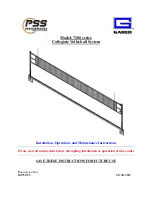
KNIGHT SMART CART OPERATION MANUAL
SECTION 4
MAINTENANCE
15
4.4 Type of Inspections
The inspection procedure is divided into two general classifications based upon the intervals at which the
inspections should be performed for the cart and chains during regular use. The general classifications are
herein designated as "frequent" and "periodic" with respective intervals between inspections as defined
below.
In addition, visual observations shall be conducted during regular service for any damage or evidence of
malfunction which might occur between regular inspections.
4.4.1 Frequent Inspection (Visual)
This is a visual examination of the cart and its chains by the operator or other designated
personnel, without requiring records to be made. This inspection should be carried out at the
following intervals:
A. Light Service
or
Service Class 0 / 1
–
Every Month
B. Moderate Service
or
Service Class 2
–
Every Two Weeks
C. Heavy Service
or
Service Class 3
–
Every Week
D. Very Heavy Service
or
Service Class 4
–
Every Day
Additionally, the operator should check the system continually during operation to ensure that no
malfunctions are occurring (such as abnormal noises or binding of the chain).
4.4.1.1 What to Look for During a Frequent Inspection
Operator should examine the chain throughout its working length to detect any evidence
of wear, distortion or external damage. Equipment should be operated under a load as
near as possible to the usual operating load, in both directions and observe the
functioning of the chain. The chain should feed smoothly into and out of the tower unit.
Additionally, the operator should check the system continually during operation to ensure
that no malfunctions are occurring.
•
Check for visual signs or abnormal noises (grinding etc.) which would indicate a
potential problem.
•
Ensure controls function properly and return to neutral when released.
•
Ensure the load chain feeds through the tower unit correctly.
•
Ensure that the chain doesn’t bind, is excessively noisy or “clicks” as it leaves the
bottom of the tower unit.
If any of these abnormal conditions are evident, the Smart Cart should be taken out of
service and a detailed inspection and corrective actions should be taken by qualified
maintenance personnel.
















































